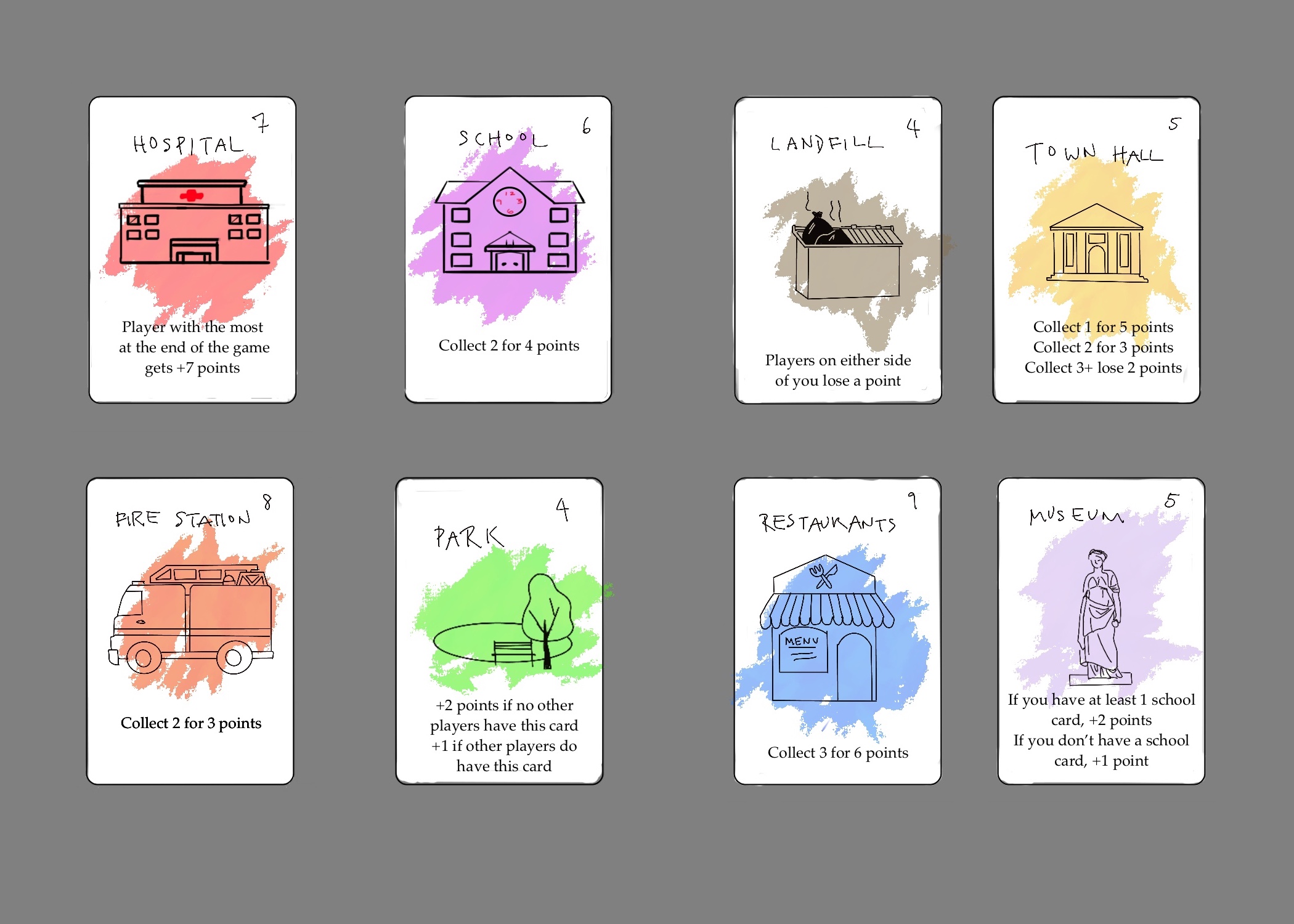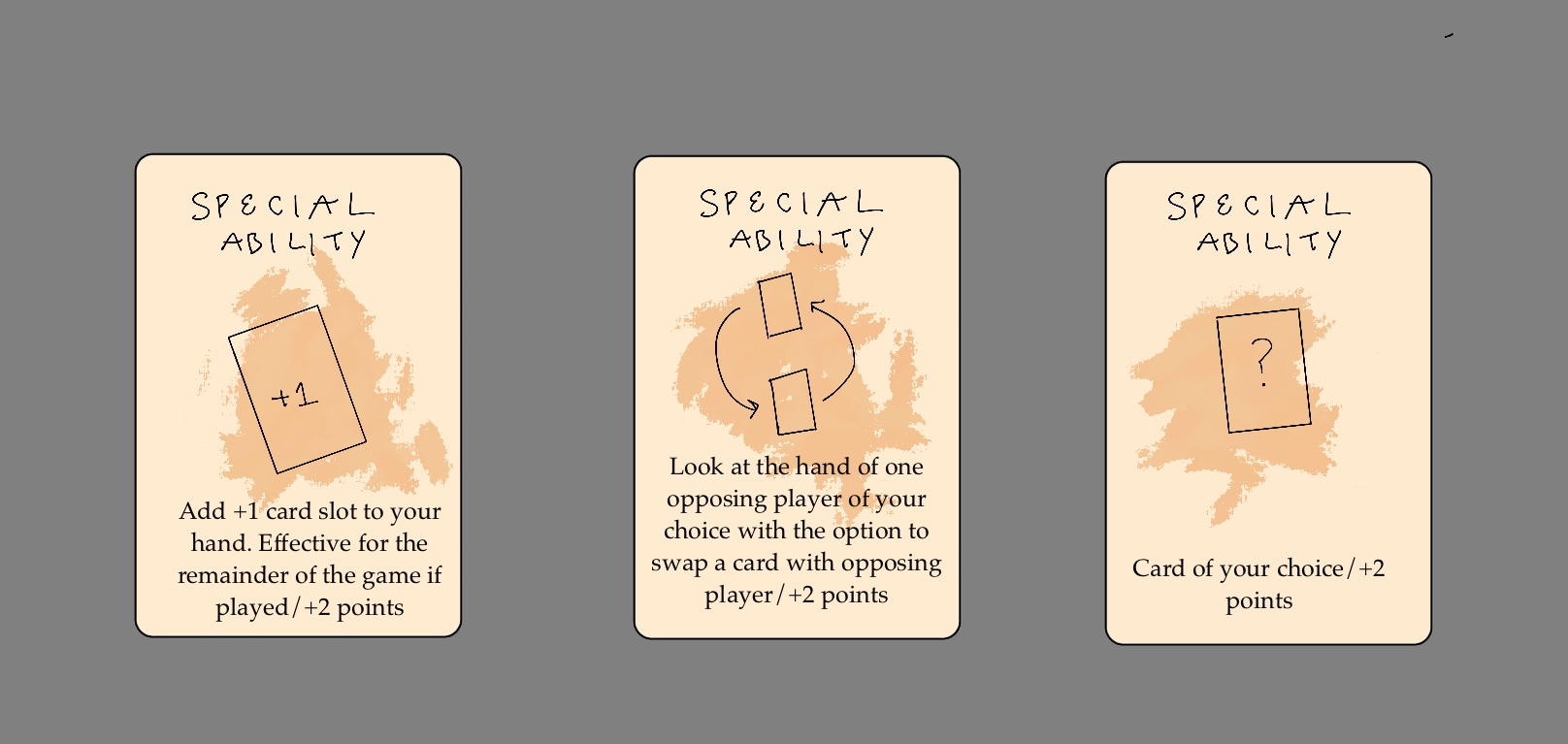
Players are competing architects in a city building competition. The objective of the game is to create the city with the highest point value in order to win the much-coveted title of "Chief City Architect" and perhaps even more importantly, bragging rights and social clout.


The custom deck features 8 normal cards and 3 special ability cards. For the normal cards, the top right corner displays a number representing the total number of that type of card in the overall deck, allowing players to strategize when building their hand.
Because the game involves passing around cards while building a hand, players are often dealing with multiple different kinds of cards that can quickly become unmanageable. To help resolve this issue, the art style of the cards is designed to be whimsical and playful, utilizing line art focused illustrations and color to assist players in quickly differentiating between different cards during play. Normal cards have a white background while special ability cards are colored a light orange. To help players manage the plethora of different card types, I also decided to include text on the bottom of each card explaining the cards' point values.
The game also focuses heavily on strategy and interacting with the other players, hence a number of the cards require players to pay attention and adjust their hand based on predictions of what other players have in their hand or what cards end up in the center.
Pictured above: final run through of the finished game
Test Play results:
The game originally started as a card building game where players would attempt to physically construct a building out of playing cards while also attacking other players' buildings, and the player whose house was built out of the most cards at the end wins. However, when I test played the game, I quickly realized that simply having players build a house of cards was exceedingly difficult and far more frustrating than it was fun. It was also far too easy for players to destroy other players' buildings. I then explored options to allow players to use additional materials to make the process easier, such as including tape, but this changed the point of focus for players such that they were no longer primarily interacting with the card itself but rather the tape, which made it feel less like a card game and seemed to alter the properties of the card. I came to the conclusion that I needed to overhaul the game structure, and instead deconstructed the game while maintaining the "buildings" theme so that each player would be trading different cards which represented various components of a building (windows, doors, etc.) worth differing amounts of points. The objective became to collect the most points instead of the most physical cards. Eventually, the different components became different parts of a city in order to make the components more interesting rather than just a collection of various rectangular objects (window, door, chimney, walls, etc.). I also found a new solution to encourage players to "attack" other players' cities where rather than physically breaking the structure, players would have to interact with cards whose point values depended on how many there were in a players' own hand and what other players had in their hands. I also introduced the idea of a set of cards in the center that players all had to interact with.
The game in this new form was test played three times, the first time as a 2 player game and the second two times as a 3 player game. Originally, the game was meant to be four rounds long, with the center cards revealed before the third round. In the first test play, what became quickly apparent was that four rounds was too long. Most of the players essentially decided their hands by the end of the first round, and only really made major changes in the 3rd round after the center cards were revealed. This was confirmed in the second test play as the same thing occurred. Thus, the game was shortened to 2 rounds.
Additionally, the game was originally designed so that the dealer would draw from the deck and pass on cards to the other players. By the end of the second test play, it was apparent that the dealer had a major advantage since they would see the cards before all other players, likely keeping the stronger cards for themselves. The game structure was then changed so that players are simultaneously passing sets of 2 cards around.
The number of cards in the center was also increased to allow more chances for players to interact with each other and dynamically affect the composition of their hand.
Throughout all of the test plays, the cards' point values and the number of each type of card were continuously changed in order to better balance the games. For instance, by the third test play, I realized that no one was bothering to collect any "park" cards, which were originally just valued at 1 point per park card. Thus, the card was changed to involve more strategy, requiring players to think through the likelihood of other players having the card. I also added the museum card after the second test play to encourage players to create combinations of cards in order to maximize points. This also offered some interesting circumstances where for example players would be relying on a card in the center for a combo point value (ie school card in the center, museum card in their own hand) and they would have to react quickly and change their cards around if another player swapped out the card in the center.
A number of "special ability cards" were edited throughout the test play process as well. Under the four-round game, there was a card that allowed players to see the cards in the middle prior to the third round, when the center cards were revealed. However, since the game was shortened, this card was removed entirely. A number of the original special ability cards were also removed to better balance the game because the cards inherently were very powerful and offered the player who employed the special ability a big advantage, so I adjusted for this advantage by decreasing the number of special ability cards and the chances players have to utilize them.
2-3 player game
Additional notes:
Players can choose not to play special ability cards between the two rounds. If players decide not to employ the special ability, special ability cards add 2 points each to the player's hand. Since special ability cards can only be played between the first and second round, if players draw a special ability card during the second round or a special ability card appears as a center card, the special ability can no longer be activated. The card must then be used as a card with a point value of 2.